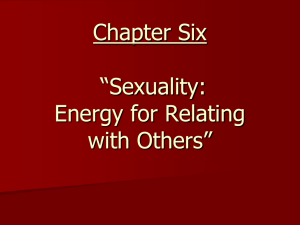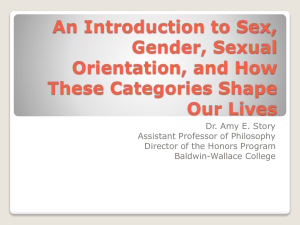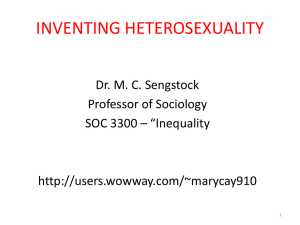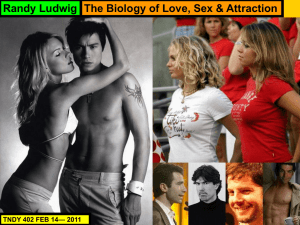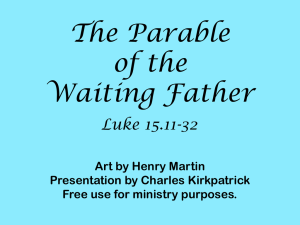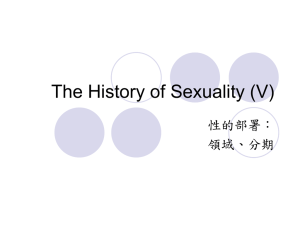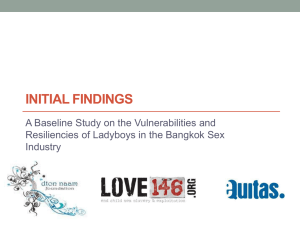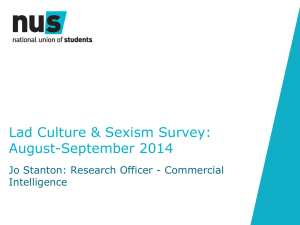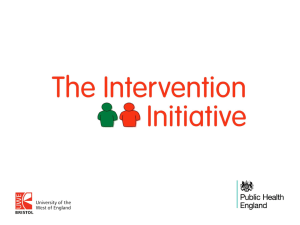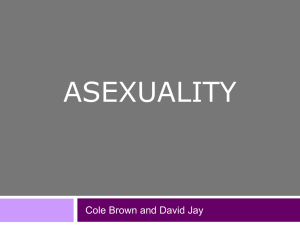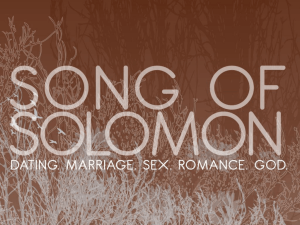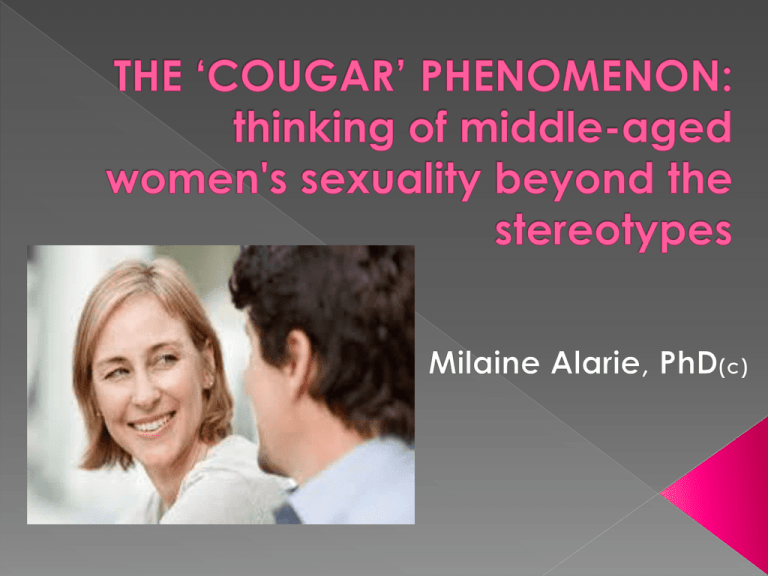
1)
2)
3)
4)
What is the ‘cougar’ phenomenon?
Cultural representations of older
women’s sexuality
Women, aging, and sexuality
Women dating younger men
Term coined in early 1990s
› Used by Vancouver hockey players
Early 2000s- became popularized
› Publication of the self-help book “Cougar: A
Guide for Older Women Dating Younger
Men” (2001)
› Creation of cougardate.com (2001)
Books
Dating websites
Boat cruises
Cougar conventions
TV shows
› Cougar Town
› Extreme Cougar Wives
Movies
› Something’s gotta give (2003)
› Adore (2013)
Newspaper articles
No official definition
› Women in their 30s and above
› Also used to describe any woman who is
dating a younger man
› Age gap varies from minimum of 3 to 10
years
› In MY research, I focus on
Women 35 or older
Age gap of minimum 5 years
Changes in the norms
› Sexual ‘Repression’ 1940s-1950s
Post-WWII: Ideology of the housewife
› Sexual Revolution 1960s
Quebec– ‘Révolution Tranquille’
› Backlash late 1970s-early1980s in the US
› Sexual Evolution 1990s - today
Influenced by:
› Changes in gender roles
› The birth control movement:
started in the 1st decade of the 20th century;
› Family planning
By 1960s, it was already an acceptable practice
› Quebecer’s rejection of the Church
› Socio-economic context of the 1960s:
Economy booming
Early 1960s: anything seemed possible
Influenced by:
› Increasing availability of erotic material
Early scholars working on sexuality
› Kinsey (1948; 1953)
› Masters & Johnson (1966)
Gay bars and bathhouses
› existed long before they became visible to
the public
“Sexual Evolution” of the 1990s
› ≠ sexual revolution of the 1960s
Women of generation X
› Born between early 1960s to the early 1980s
› Women of generation X are taking charge
of their sex lives
2 major shifts since the 1970s :
1) Women of generation X’s sexual profiles
are becoming remarkably similar to men’s
1) age of first intercourse
2) number of sexual partners
2) Male-defined scripts/norms are being
challenged
Men and women: different norms and
expectations
› Sexual double standard
› Gendered double standard of aging
› Importance of physical appearance
› Cultural opposition between motherhood
and sexuality
Very old norm
› Middle-ages: chastity belts for women;
› 16th-17th century women were burned at
the stake as witches;
› 19th century and the Victorian Era
Requiring women to profess a total lack of
sexual feeling
Sex = only for reproduction
Gendered norm
› Fatherhood ≠ asexuality
Motherhood= women should focus on
their role as a mother
› Sexuality as secondary or no longer
important
› Sexual expression = must now be reserved for
private sphere
2/3 of women think that when a woman
becomes a mother, she should change
her sexual expression(Montemurro & Siefken, 2012)
› E.g. the way she dresses; flirting; etc.
The more sexual a woman
is perceived to be,
the worse she is seen
as a mother (Friedman et al. 1998)
Definition:
› in terms of perceived attractiveness and of
normative sexual behavior, as they age,
women are judge more harshly than men.
Aging women: thought of as unattractive and
(preferably) asexual
Aging men: attractiveness in both the
romance and job markets holds steady or
even increases with age
Media’s depiction of older men/ women
› Fewer older women than men
› Older women’s sexuality=
Often muted (e.g. older women as asexual
mothers)
Destabilising the nuclear family
Funny
Dangerous
BUT– increasing number of middle-aged
women on TV
› Which women are presented on TV?
Men’s value=
› Associated with their occupational status and
their wealth
Men are valued for their intelligence, their sports
abilities, their leadership
Men gain value as they age
Women’s value=
› Primarily determined by their physical
appearance and their ability to attract the
attention of men
› Beauty= youth
Women loose value as they age
Some feminists argue that beauty standards=
› a tool to prevent women from getting power, from
destabilizing the patriarchal system where men are
at the top
The argument:
› Women’s value= first and foremost determined by
their beauty/youth
› As women become older, they become smarter,
wealthier, therefore potentially more powerful
so their beauty is said to decrease
Goal: limit women’s power, by affecting their selfesteem, and others’ perception of older women’s
credibility
› Result= women cannot destabilize patriarchy
In other words, for women, sexual activity
is generally thought as being
acceptable only for:
› the childless pretty young adult woman in a
serious monogamous long-term relationship
How do our assumptions influence the
way we treat aging women?
Older women choosing younger men as
sexual partners break many norms and
challenge many assumptions regarding
women’s sexuality
› Women are, like men, interested in sexuality
even ‘flings’ or ‘one-night-stands’
› Women can be assertive
› Aging women are attractive
› Aging women are sexual being
› Being a mother does not mean asexuality
Effect of menopause on women’s
sexuality: inconsistencies in scientific
literature
› Some experience decline in sexual desires,
and/or pain during intercourse
› Others report increased sexual desire, and/or
increased sexual activity
› Some report no change at all
Importance of contextual and relational
factors
› Past sexual dysfunction
› Being married/single
› Relationship length
› Level of intimacy
with partner
› Feelings for partner
Issue= reducing women’s sexuality to
their reproductive functions
› Gendered representations of parenthood and
sexuality:
women = mothers
Women’s sexuality= reproduction
Decline in sexual activity for both men
and women at middle age and beyond
Gender differences
Example- Among 40-59 year olds:
› Larger proportion of women report having
no sexual partners
› Women: tend to have limited or no sexual
activity at a younger age than men
› Men = 3 times more likely than women of the
same age to report having multiple sexual
partners at a given point in time.
79% of middle-aged women (aged 42-52
years old) had engaged in sex with a
partner in the last 6 months
(Cain 2003)
Common reasons for no sex
› were lack of partner (67%)
› lack of interest (33%)
› fatigue (16%)
(Cain 2003)
:
Middle-aged women in U.S.
(Alarie & Carmichael 2014)
› 86% of women had had sex in last 12 months
› Among sexually active women, in last 12 months
Number of sex partners:
90% --one partner
7 % -- 2 partners
3 %-- 3 or more partners
Marital status of those who had 2 or more sex
partners in the last 12 months
3% of married women
18% of single never-married women
28% of previously married women
Single middle-aged women in Quebec
› Sexually active women: # of partners in last 5
years
21% --had 1 partner
45%-- 2 or 3 partners
27%-- 4-6 partners
7% -- 7 and more partners
Condom
use among single middleaged women in QC (last 2 partners)
› Vaginal intercourse
33% used condoms all the time
43% reported never having used condoms
› Anal intercourse
21% used condoms all the time
77% never used a condom
From age 35 and on, the ratio of single
women versus single men begin to increase
› unbalanced pool of potential opposite-sex
partners
› Sex differences in mortality rates= play a limited
role, and it does so only passed age 45
› Aging and the age-gap between partners
The older a man is when he gets married, the
younger is bride will likely be
Men marrying in their 20s: 1 year age-gap
Men marrying in their 60s: 9 to12 years age-gap
Personal ads (Jagger 2005)
35-44 age-group
Advertising for a partner who is 34 or younger:
47%of men vs
8 %of women
Ideal partner (Montenegro 2003) :
› 40-69 age-group
majority of men (26%) prefer a female partner who is 4 to 9
years younger
majority of women (33%) prefer a male partner who is 1 to
4 years older
Reporting wanting a partner who is at least 5 years
younger:
64% of men vs
17% of women
Differentiating between different
commitment level (Buunk et al. 2001)
› Men:
the less committed (casual sex), the younger
the ideal woman is
› Women:
regardless of the commitment level, women
want men of a similar age
Age heterogamy- 2 types
› Hypergamy (older man)
› Hypogamy (older woman)
Average age gap at 1st marriage:
› Today=
2 years
(Canada and U.S.)
› Early 20th century=
3.5 years in Canada
4 years in the US
Man at least 4 years older :
› Canada: 36% of marriage/common law
unions
› US: 32.3% of marriages
Woman at least 4 years older:
› Canada: 6% of marriage/common law
unions
› US: wife is at least 4 years older in 7.6% of
marriages
Age-gap of minimum 10 years
(Canada):
› Hypergamy: 7% of marriage/common law
› Hypogamy: 1%
2 research questions:
a) How prevalent are age-hypogamous
sexual relationships in the United States?
b) What are the socio-demographic
characteristics associated with the middleaged women who engage in these nonconventional relationships?
The socio-demographic factors analysed:
› Woman’s age
› Her race
› Her education
› Her income
› Her marital status
› Her religious faith and level of religiosity
› Her attitudes towards sexuality/gender roles
› Her number of sexual partners in last 12 months
(control)
Focus= sexual relationships
› Sample=
U.S. Women aged 35-44
Sexually active women only
› Looked at all sexual partners in the last 12
months
› The outcome: women engaging in agehypogamous sexual relationships (‘cougars’)
Having slept with at least 1 man who is a
minimum of 5 years her junior in the last 12
months
Age-hypogamy
› 13% of women have slept with a man who is
at least 5 years younger
› 4.5% of women have slept with a man at
least 10 years younger
Age-hypergamy:
› 34% of women have slept with at least one
man who was 5 years older or more
› 14% of women have slept with a man at
least 10 years older or more
Women’s Income:
› lower income women are more likely than affluent women
to have sex with younger men
Women’s race:
› Women who identify as either White or Black are less likely
than those of ‘other racial groups’.
Women’s marital status:
› Previously married women are more likely than
married/cohabiting women to engage in agehypogamous sexual relationships
› No difference between never married women and
married women
› Majority of older woman/younger man sexual relationships
actually involve married/cohabiting women
Conservative attitudes:
› Agreeing with the statement that “any sexual
acts between consenting adults is all right”–
increases the likelihood of sleeping with a
younger man
Religion:
› Women who never go to Church are more likely
than those who go regularly to sleep with a
younger man
Women’s level of education:
› Not significant
Longevity?
Marrying their younger partner?
Looking for Canadian women
Aged 35-55
Goal= Understand women’s experience of
age-hypogamy in the heterosexual dating
context
› a) motivations for challenging the age hypergamy
norm and expectations with regards to the future of
the relationship;
› b) perceived benefits, disadvantages and risks
associated with age hypogamy;
› c) feelings towards cultural representations of older
women and ‘cougars’, and stigma management;
› d) identity choices/negotiations and gender
performances
Alarie & Carmichael (2014). The cougar phenomenon: Examining the factors influencing age-hypogamous
sexual relationships among middle-aged women. Manuscript submitted for publication.
Birnbaum et al.(2007). Is it all about intimacy? Age, menopausal status, and women’s sexuality. Personal
Relationships, 14(1), 167-185.
Buunk et al. (2001). Age preferences for mates as related to gender, own age, and involvement level.
Evolution and Human Behavior, 22(4), 241-250.
Cain et al. (2003). Sexual Functioning and Practices in a Multi-Ethnic Study of Midlife Women: Baseline
Results From SWAN. Journal of Sex Research, 40(3), 266-276.
Davis & Fiona. (2011). Sex and Perimenopause. Australian Family Physician, 40(5), 274-278.
Dedobbeleer et al. (2005). Social Network Normative Influence and Sexual Risk-Taking Among Women
Seeking a New Partner. Women and Health, 41(3), 63-82.
Dennerstein& Lehert (2004). Modeling Mid-Aged Women's Sexual Functioning: A Prospective, PopulationBased Study. Journal of Sex & Marital Therapy, 30(3), 173-183.
Friedman, Weinberg & Pines (1998). Sexuality and Motherhood: Mutually Exclusive in Perception of Women.
Sex Roles, 38(9/10), 781-800.
Jagger (2005). Is Thirty the New Sixty? Dating, Age and Gender in a Postmodern, Consumer Society.
Sociology, 39(1), 89-106.
Gannon (1999). Women and aging : transcending the myths. London; New York: Routledge.
Gibson (2002). Cougar: a guide for older women dating younger men. New York, NY: Firely Books.
Kamen (2000). Her way : young women remake the sexual revolution. New York: New York University.
Montemurro & Siefken (2012). MILFS and Matrons: Images and Realities of Mothers' Sexuality. Sexuality &
Culture, 16(4), 366-388.
Mansfield et al. (1995). Predictors of Sexual Response Changes in Heterosexual Midlife Women. Health
values., 19(1), 10.
Montenegro. (2003). Lifestyles, Dating and Romance: A Study of Midlife Singles. Washington, DC: American
Association of Retired Persons (AARP).
Wolf (1991). The beauty myth : how images of beauty are used against women. New York: W. Morrow.
Milaine Alarie PhD (c)
Department of Sociology
McGill University
milaine.alarie@mail.mcgill.ca



